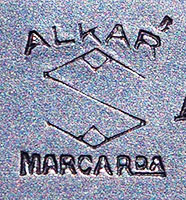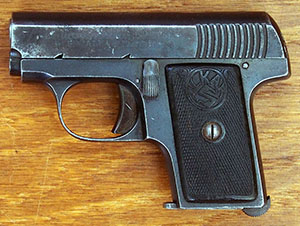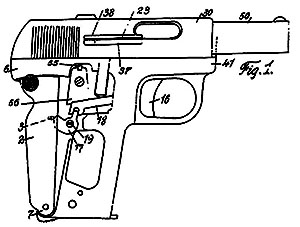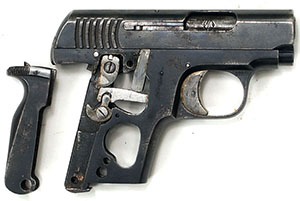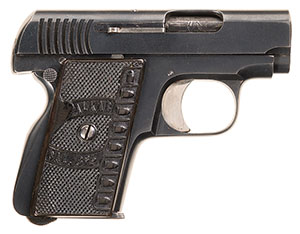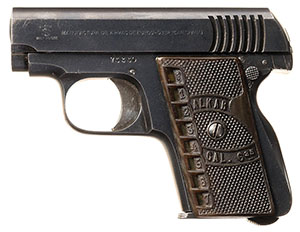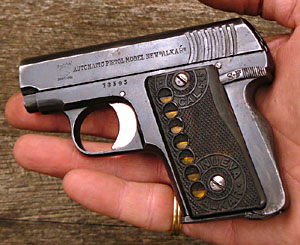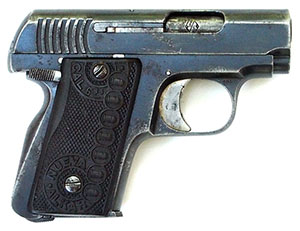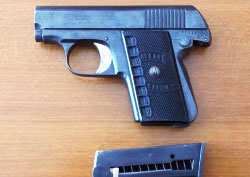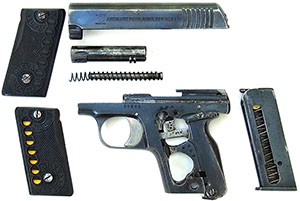 |
|||||||||||||||||||||||||||||||||||||||||||||||||||||||||||||||||||||||||||||||||||||||||||||||||||||||||||||||||||||||||||||||||||||||||||||||||||||||||||||||||||||||||||||||||
|
The Alkar and Nueva Alkar by Ed Buffaloe
The Alkar name was granted as a trademark on 11 August 1914. In 1914, Alkartasuna began production of a 6.35mm pistol with a loaded chamber indicator on top, marked on the left side of the slide: 6.35 MODEL AUTOMATIC PISTOL / 1914 ALKAR PATENT. According to Adair: “Total production of the first 6.35 mm model was 4,072 before production was halted and shifted due to the start of the First World War.” Alkartasuna became a subcontractor making the “Ruby” pistol during World War I, eventually producing approximately 20,000 seven-shot pistols and 50,000 nine-shot pistols. Within a few years the Alkartasuna company held a similar status to that of Esperanza y Unceta--both were regarded as bulwarks of the local economy. Antaris states: ‘In August 1915, the firm registered the PANAMA trademark (#25441) in which the word “Panama” was arched over Alkar’s readily recognizable “angular S.”’ Adair relates that the “angular S” trademark is a representation of the Panama Canal, which opened in 1914, but he further states that neither the Panama name nor the Panama trademark which they registered were ever used by Alkartasuna.
The Alkartasuna factory was destroyed by fire on 13 May 1922. The factory equipment and factory inventory were a total loss. In 1923 the firm San Martin, Alberdi y Cia of Guernica was founded and registered the Alkar trademark with the Eibar proof house. There is some speculation that the company was funded by Esperanza y Unceta, and when they closed in 1927 all their assets were taken over by Esperanza y Unceta. But, from around 1924 through 1927, San Martin, Alberdi y Cia continued to make guns under the Alkar name, after which it is considered likely that Esperanza y Unceta continued production of Alkar pistols until about 1933. Matthews, in his classic book Firearms Identification, notes that the Alkar cartridge counter pistol bears a quite different inscription from the earlier Alkar pistols and says: “This suggests that this pistol was made by a different firm or a reorganized firm to which was given a new name.” Antaris comments: “His suggestion remains controversial, for the pistol could have been subcontracted while Alkar was in business. The cartridge counter’s serial numbers...were contemporary to Alkar’s sequencing that continued to about 83000.” However, Ortuñez notes, in his monograph on the Alkartasuna company, that the name Manufactura de Armas de Fuego, Guernica was a trade name used by the Alkartasuna company in various correspondence and on letterheads prior to 1922, so perhaps we should not read too much into the name. Ortuñez also states that in addition to the factory the company had two warehouses, and that after the fire, between 1922 and 1924, the company sold remaining stock from their warehouse under the name Manufactura de Armas de Fuego, Guernica. Alkar cartridge indicator pistols that I have documented include serial numbers 74868, 75007, 75056, 75063, 75187, 75243, 75274, 75350, and 75797. Nueva Alcar pistols I have documented include serial numbers 76395 and 201050.*
The French patent explains that most pistols can be placed into either of two conditions, with the hammer cocked, or with the hammer uncocked. But the Alkar pistol can be placed in a third condition, which is essentially with the hammer in a half-cock state. By pressing the rear grip lever and the trigger at the same time the hammer can then be moved to full cock and the gun fired. The patent describes in detail the functioning of the rear grip lever, which is referred to as the “détente.” As a verb this French word means “relaxation,” and as a noun it is the term most often used for trigger. So the grip lever is not referred to as a safety lever, but rather as a trigger or release which only secondarily activates the safeties. Also described are the loaded chamber indicator beneath the extractor, the mechanism for locking the slide, the magazine with its cartridge indicator slot, and the grip plate with holes for viewing the cartridges. Lastly, the patent describes a recoil buffer spring to cushion the recoil of the slide which was not implemented in the production pistol. The patent drawing shows a pistol with a bushing to cover the barrel at the front of the gun similar to those on the Walther Models 4 and 7--this bushing was also not implemented in the production gun.
The Alkar cartridge indicator pistol is a most unusual gun, and a clear design departure. While based (like the Ruby or Eibar-type pistols) on the 1903 Browning design, the Alkar has a number of unique features, including a loaded chamber indicator, a grip lever at the rear that activates the safety and is also depressed to fire the first shot, and numbered windows in the left grip panel that allow the shooter to see how many cartridges remain in the magazine. The magazine has a vertical slot on the left side and a shiny brass plate attached to the bottom of the magazine follower that is visible through the windows in the grip. The brass cases of the cartridges above the follower show through the windows, as does the brass plate itself, and as each cartridge is fired the windows darken one by one.
The spring-loaded plunger is also used to lock the slide open for cleaning. When the slide is pulled all the way to the rear and at the same time the grip lever is engaged, the plunger moves down into a hollow in the slide rail, locking it open. The first shot is fired by squeezing the grip safety and pulling the trigger at the same time. As the rear lever is squeezed, the hammer moves to the full cock position, the connector bar and trigger are unlocked, and the gun can be fired. After firing the first round, the grip lever remains disengaged, and the subsequent single-action trigger pull is quite light. The loaded chamber indicator is a small lever beneath the extractor, the forward end of which is pressed outward when there is a round in the chamber. At the rear of the lever is a small protuberance which is depressed when the forward portion of the lever is pushed outward by the cartridge. Hence it is possible to determine if there is a round in the chamber either by sight or by feel. Additionally there is a numeral zero (0) on the upper surface of the protuberance and a numeral one (1) on the forward portion of the cartridge indicator, though these numerals are never fully visible.
The right grip plate has eight squares along the forward edge, the bottom seven with a horizontal cartridge pointing forward, and the topmost square having a cartridge pointing upward. The grip plates are of checkered horn with the word ALKAR arcing over the single grip screw and CAL. 635 beneath. The slide has seven curved serrations at the rear to facilitate cocking, and is marked on the left side with the Alkar “angular S” trademark followed by the inscription in all capital sans-serif characters: MANUFACTURA DE ARMAS DE FUEGO - GUERNICA ( ESPANA)
The right side of the slide is blank. The serial number is on the left side of the frame above the trigger. The finish is in salt blue with a nickel plated trigger. The left side of the rear grip lever is marked “S&F”, such that when the lever is in its forward position the “S&” are hidden beneath the grip plate. Only the “F” is visible, indicating the gun is ready to fire. There is a round checkered button-like protuberance on each side of the lever at the top to enable the lever to be gripped and pulled to the rear to make the gun safe. Matthews describes this as a “safety ... of the push-through type,” and Antaris describes it as “a push button at the rear that lock[s] the safety.” Quite possibly neither of these authors ever examined an Alkar cartridge indicator pistol in person. The protuberance is not a button and cannot be pushed in--it is merely a grasping surface used to move the lever. A small side plate on the left side of the grip tang covers the plunger mechanism that locks the slide.
AUTOMATIC PISTOL MODEL NEW “ALKAŔ” The slide serrations remain unchanged from the earlier variant. The serial number remains on the left side of the frame, above the trigger. The finish is in salt blue with a nickel plated trigger. The right side of the slide is unmarked, although the right side of the frame of the Nueva Alkar shown here has the word SPAIN stamped on the bow of the trigger guard, probably indicating it was exported to the U.S. The grip plates are of checkered horn and are marked NUEVA ALKAR in a circle around the lower grip screw and CAL 635 beneath the upper grip screw. The seven windows on the left grip plate are semi-circular and are numbered from 1 through 7. The uppermost window with the question-mark has been eliminated. The brass index on the magazine is completely internal and descends vertically from the follower. The slot opening in the magazine is rounded at the bottom. The grasping surface on the rear lever has been redesigned and is now a slightly curved raised band at the top with vertical serrations at its rear. The forward portion of the band is marked “S -F”. The back of the grip plates are notched so the raised bands will fit under them. The New Alkar does not have the small side plate at the rear of the left grip tang. Instead, the opening for the slide lock plunger is drilled into the bottom of the grip tang and covered by the rear grip lever.
An unusual Nueva Alkar specimen with a very high serial number (201050) has come to my attention. It differs from earlier specimens in that it is stamped CAL 635 on the left side of the slide in front of the Alkar logo. It is also stamped “EIBAR 1924,” apparently by hand, above the normal slide inscription, and it has proof marks, which would indicate a manufacture date after 1923. In addition, the loaded chamber indicator does not have the raised area at its rear. This represents a clear sub-variant of the Nueva Alkar, and was probably made by the above-mentioned San Martin, Alberdi y Cia.
Finally, Pawlas illustrates a pistol that is slightly larger than the Alcar or Nueva Alcar with somewhat the look of the earlier “Ruby” style 6.35mm pistols, but with the front of the slide and frame looking more like the late Alkar 1910 FN Browning copies, typically seen in the 80,000 serial number range. This pistol has a manual safety on the left side just above and behind the trigger, and has no rear grip lever and no loaded chamber indicator, but does have the cartridge counter grip plates and magazine of the Alcar (first variant) pistol. It has proof marks and a three -line slide inscription as follows: STANDARD AUTOMATIC PISTOL This gun is probably also an example of San Martin, Alberdi y Cia, using remaining magazines and grip plates from the first Alkar cartridge counter pistol. But this in turn implies that they or someone must already have possessed these parts at the time the Alkartasuna factory was destroyed.
Field Stripping
Unfortunately, the slide does not lock open at the correct point for turning the barrel, so you have to hold it open with your left hand while twisting the barrel with the right. I usually wear a leather glove on my left hand in order to grasp the slide firmly enough to hold it back against the force of the recoil spring. If you pull the rear lever back with the slide off it will allow the slide-lock plunger to descend and
I urge caution when handling these guns. I had a round fire when I was chambering it, even though I was careful not to have my finger on the trigger. I may not have
pulled the slide back quite far enough for the sear to fully engage the hammer. Fortunately, I was outside with the gun pointed in a safe direction, so the bullet just went
into the dirt. And, most of important of all, my wife wasn’t home at the time. The incident, along with the very light trigger pull, indicates to me that the sear or
hammer cocking notch may be inadequate, or possibly worn. The gun’s design requirements may have exceeded the manufacturer’s capabilities. It is a very interesting and ambitious, if overly
-complex, design. |
|||||||||||||||||||||||||||||||||||||||||||||||||||||||||||||||||||||||||||||||||||||||||||||||||||||||||||||||||||||||||||||||||||||||||||||||||||||||||||||||||||||||||||||||||
|
Copyright 2009-2016 by Ed Buffaloe. All rights reserved. |
|||||||||||||||||||||||||||||||||||||||||||||||||||||||||||||||||||||||||||||||||||||||||||||||||||||||||||||||||||||||||||||||||||||||||||||||||||||||||||||||||||||||||||||||||
|
|||||||||||||||||||||||||||||||||||||||||||||||||||||||||||||||||||||||||||||||||||||||||||||||||||||||||||||||||||||||||||||||||||||||||||||||||||||||||||||||||||||||||||||||||
|
|
|||||||||||||||||||||||||||||||||||||||||||||||||||||||||||||||||||||||||||||||||||||||||||||||||||||||||||||||||||||||||||||||||||||||||||||||||||||||||||||||||||||||||||||||||
